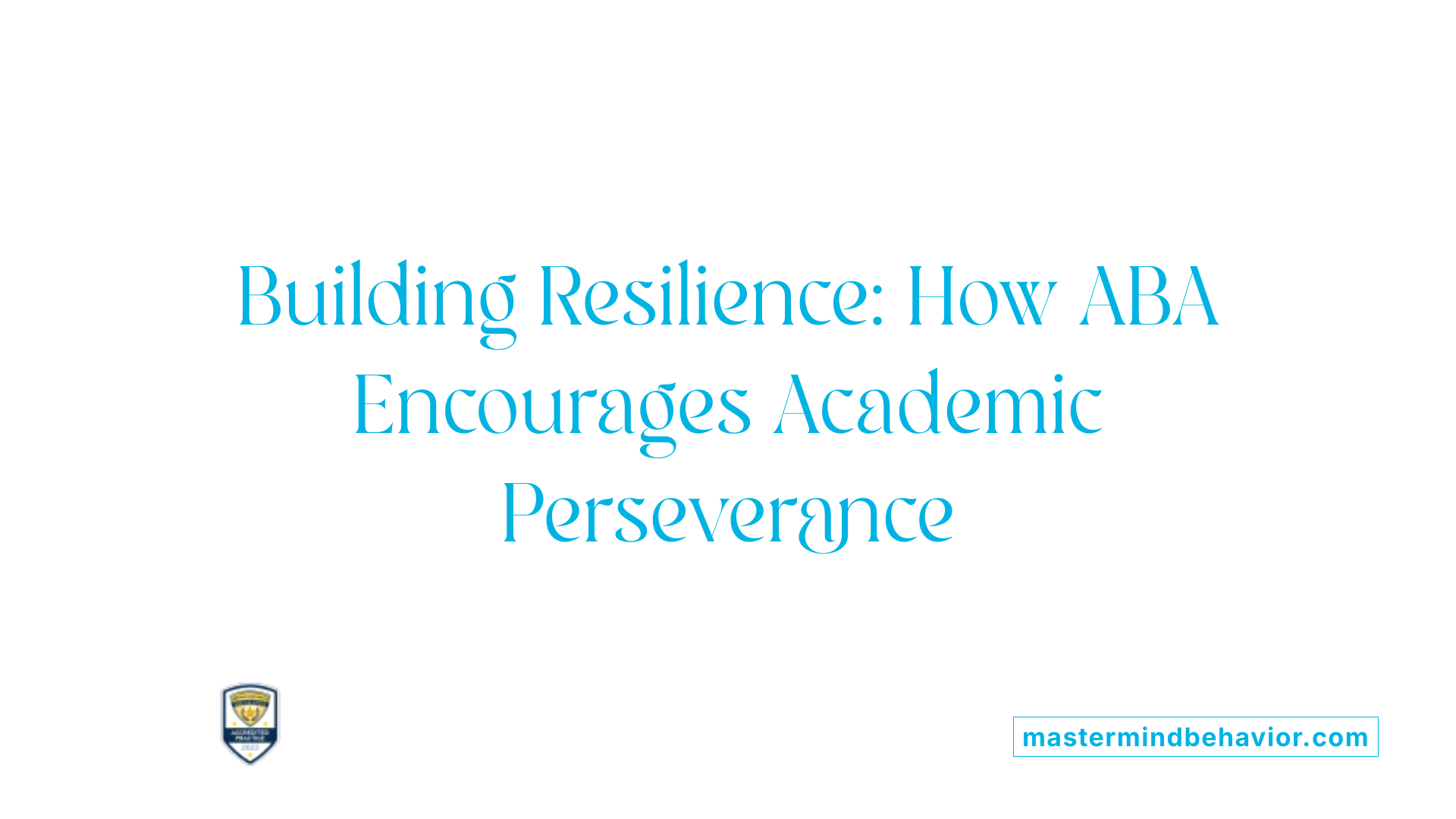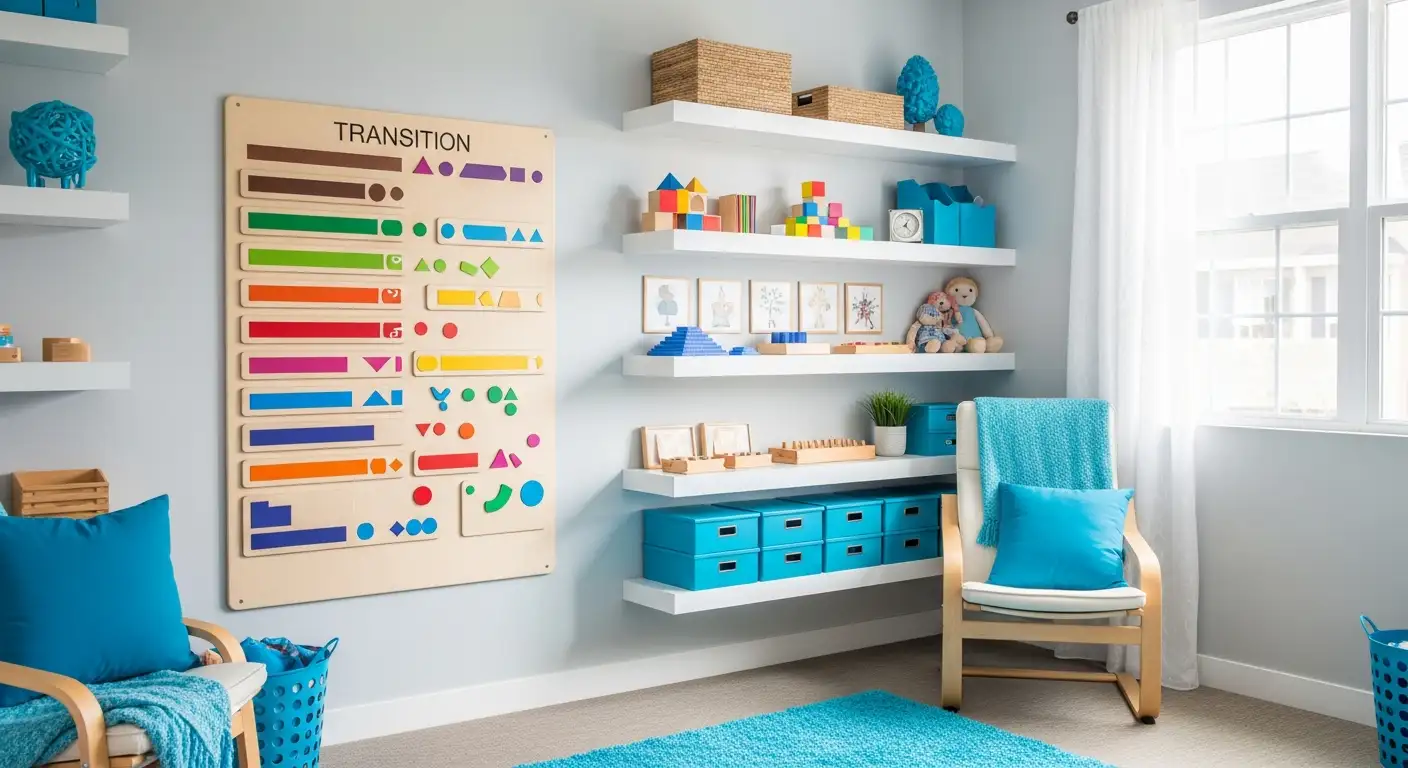Understanding ABA Therapy and Its Role in Autism Support
Applied Behavior Analysis (ABA) therapy stands out as a scientifically validated intervention designed to support children with autism spectrum disorder (ASD) and other developmental disabilities. By breaking complex behaviors and skills into manageable parts, ABA therapy provides a clear path for academic and personal growth. This article explores the strategies within ABA therapy that specifically bolster academic perseverance, drawing from evidence-based approaches and family-centered practices.
Foundations of ABA Therapy: A Scientific Approach to Behavior and Learning

What is Applied Behavior Analysis (ABA) therapy?
Applied Behavior Analysis (ABA) therapy is a scientifically grounded method designed to enhance social, communication, and learning skills primarily in individuals with autism spectrum disorder (ASD) and other developmental disabilities. It focuses on understanding and modifying behaviors by analyzing their environmental triggers and outcomes.
Core Principles and Methodology of ABA
ABA therapy operates by breaking down complex behaviors into smaller, measurable components. Through careful assessment, personalized goals are set, and skills are taught step-by-step to facilitate learning. Positive reinforcement is the cornerstone, rewarding desired behaviors to increase their frequency. Structured teaching strategies such as Discrete Trial Training and Natural Environment Teaching (NET) are employed to generalize skills across settings.
Techniques Used in ABA Therapy
Behavior modification in ABA includes prompting, modeling, and reinforcement. Prompting involves guiding a child to perform a behavior, while modeling has caregivers or therapists demonstrate the desired skill for imitation. NET capitalizes on natural daily interactions, turning routine moments into learning opportunities, which boosts skill generalization. Data collection and continual evaluation by behavior analysts ensure that interventions are effective and adapted to the trainee's progress.
Through this evidence-based approach, ABA therapy helps children acquire new abilities, reduce problematic behaviors, and gain independence, facilitating participation in everyday environments and improving overall quality of life.
How ABA Therapy Supports Academic Perseverance in Children with Autism

How does ABA therapy support individuals with autism?
ABA therapy provides a structured and individualized approach designed to enhance learning, communication, social, and academic skills in children with autism. It targets increasing positive behaviors that contribute to learning and independence while minimizing challenges through consistent, positive reinforcement within supportive environments.
Individualized interventions focusing on academic and social skills
ABA therapy breaks down complex academic and social skills into smaller, manageable components. By tailoring interventions to a child’s unique needs and abilities, ABA helps build foundational skills essential for academic perseverance. These personalized goals promote incremental learning, with progress monitored closely to ensure continuous development.
Increasing helpful behaviors related to learning and independence
Positive behaviors such as attending to tasks, asking for help, following instructions, and practicing self-help skills are encouraged and reinforced consistently. This reinforcement strengthens persistence and motivation, enabling children to overcome academic challenges and build resilience over time.
The role of positive reinforcement and structured environments
ABA emphasizes positive reinforcement strategies where desired behaviors are rewarded to increase their occurrence. Structured environments that minimize distractions and provide clear expectations further support the child’s ability to focus, engage, and persist in academic activities. Techniques like Natural Environment Teaching (NET) build skills in real-life settings, increasing generalization and relevance, which are crucial for sustained academic effort.
Together, these elements form a comprehensive approach that cultivates perseverance, independence, and confidence in academic settings for children with autism.
The Critical Role of Family Involvement in ABA Therapy Success

Active Family Participation and Consistency at Home
ABA therapy's effectiveness heavily depends on the family's active involvement. Parents and caregivers play a crucial role in consistently applying therapeutic strategies and reinforcing desired behaviors outside therapy sessions. By maintaining a structured and supportive home environment aligned with ABA principles, families help children generalize skills learned during therapy to real-life contexts.
Parents’ Roles in Emotional Support, Progress Monitoring, and Advocacy
Parents offer essential emotional support that fosters a child's confidence and motivation throughout therapy. They also monitor developmental progress closely, noting changes and challenges to share with therapists. This ongoing feedback helps tailor interventions to the child's evolving needs. Furthermore, parents advocate for appropriate educational and community resources, ensuring their child receives comprehensive support.
Collaboration and Open Communication Between Families and Therapists
Effective ABA therapy thrives on strong partnerships between families and therapists. Open communication allows caregivers to stay informed about therapeutic goals, methods, and outcomes. It also creates a collaborative atmosphere where parents can express concerns and contribute insights about their child's preferences and responses. Such teamwork enriches treatment quality and promotes consistency across all environments, maximizing the therapy's success.
Empowering Parents: Education and Training to Support ABA Strategies

How can parents educate themselves on ABA techniques?
Parents are encouraged to become well-informed about ABA therapy by exploring various educational resources. This includes reading literature on ABA strategies, attending informational sessions, and joining support groups where they can learn from experienced families and professionals. By understanding the foundational principles of ABA, such as positive reinforcement and structured learning, parents can better support their child's progress.
What training opportunities are available for parents?
Training programs and workshops offer practical knowledge and hands-on experience with ABA methods. These sessions are designed to teach parents how to implement ABA strategies effectively at home, collaborate with therapists, and monitor their child's development. Many centers provide ongoing support through group meetings and forums, fostering a network where parents can share successes and challenges.
How do parents practically integrate ABA strategies into daily routines?
Parents play a vital role in applying ABA techniques by embedding them into everyday activities. For example, during mealtime, they might practice naming objects or encourage decision-making by giving choices. Playtime can be an opportunity to model turn-taking and cooperation, while routine tasks like dressing can include problem-solving exercises. This natural integration reinforces learning and helps the child generalize new skills across settings.
By actively participating in education and training, parents not only enhance the effectiveness of ABA therapy but also create a nurturing and consistent environment that supports their child's growth and independence.
Natural Environment Teaching (NET): Learning in Real-Life Contexts

What is Natural Environment Teaching (NET) in ABA therapy?
Natural Environment Teaching (NET) is a systematic approach within Applied Behavior Analysis (ABA) therapy aimed at teaching children skills in everyday settings rather than clinical or isolated environments. By embedding learning opportunities into real-life contexts, NET focuses on making newly acquired behaviors and skills more meaningful and easier to generalize outside therapy sessions.
How does NET promote practical skill application and generalization?
NET helps bridge the gap between therapy and daily life by utilizing natural settings—like the home, playground, or community spaces—to teach skills. This approach makes learning more relevant and durable, as children practice behaviors in the environments where those skills naturally occur. For instance, children learn communication by choosing between snacks or participate in social play to better develop turn-taking and cooperation.
Examples of NET activities that enhance communication, problem-solving, and social development
- Communication: Caregivers prompt children to select items during meals (e.g., choosing between an apple or a banana), encouraging language use and decision-making.
- Problem-Solving: Routine activities such as cooking or measuring ingredients engage children in understanding concepts like quantity and sequencing in a fun, practical manner.
- Social Skills: Unstructured play with peers and everyday interactions foster skills such as cooperation, negotiation, and sharing.
A child-led approach within NET ensures children’s interests guide learning moments, increasing motivation and skill retention. By involving caregivers who model behaviors and create teachable moments during daily routines, NET integrates learning seamlessly into the child's life, supporting their independence and social growth in a natural way.
Child-Led Approaches and Modeling in ABA Therapy
Why is engaging children based on their interests important in ABA therapy?
Engaging children according to their individual interests is central to the child-led approach in ABA, particularly within Natural Environment Teaching (NET). When therapy activities reflect what the child is naturally drawn to, motivation and relevance of learning increase significantly. This approach helps maintain the child's attention and enthusiasm, which are crucial for better retention of new skills and making therapy feel less like work and more like play.
How do modeling and imitation techniques aid communication and motor skills development?
Modeling and imitation are foundational techniques in ABA. Caregivers and therapists demonstrate desired behaviors, language, or motor tasks for children to replicate. This method supports the natural development of communication skills and motor abilities by offering clear, tangible examples. Through consistent modeling, children learn not only how to perform specific actions but also how to use language effectively in social contexts.
In what ways do child-led and modeling methods support skill retention and learning engagement?
By combining child-led activities with modeling and imitation, ABA therapy creates a dynamic and interactive learning environment. When children are engaged through their interests, they are more likely to pay attention and practice new skills. Modeling provides concrete examples to imitate, which reinforces learning. This integrated approach encourages active participation, which in turn boosts skill retention and overall engagement with therapy sessions.
Implementing NET at Home: Turning Daily Routines into Learning Opportunities
How can teaching moments be embedded in meals, play, and dressing?
Natural Environment Teaching (NET) encourages parents to integrate learning within everyday activities. During meals, caregivers can name objects, such as foods or utensils, prompting the child to identify items or make choices, for example, "Would you like an apple or a banana?" This builds language and decision-making skills.
In playtime, practicing turn-taking and problem-solving can be achieved through games or activities like cooking, where measuring ingredients introduces concepts of quantity and sequencing. During dressing routines, asking the child to choose clothing items or assist with buttoning turns a daily task into a learning opportunity that encourages independence.
How does NET promote independence and academic persistence through everyday activities?
By involving children in routines and decision-making, NET promotes not only skill acquisition but also perseverance. Age-appropriate tasks help children develop self-help, communication, and life skills incrementally. For example, helping set the table cultivates responsibility and focus, while encouraging participation in chores reinforces routine adherence and academic persistence.
How can teaching be balanced with natural interaction and fun?
A successful NET approach maintains a child-led focus where learning aligns with the child's interests, keeping motivation high. Fun activities and unstructured play are essential to support social development and cooperative skills without the therapy feeling forced. Caregivers should allow natural interaction and enjoyable moments, using them as subtle teaching opportunities rather than overly structured lessons.
This balance makes daily life a rich learning environment, embedding ABA goals seamlessly into the child's natural settings.
Age-Appropriate Skill Building to Foster Academic Perseverance Across Developmental Stages
Tailoring Communication, Self-Help, Academic, and Life Skills by Age Group
ABA therapy emphasizes individualized skill-building activities that evolve with the child’s developmental stage. For toddlers, the focus often lies in foundational communication—like making choices between objects—and early self-help tasks such as dressing or feeding. As children grow, these activities expand to include more complex self-care and basic academic skills.
Supporting Toddlers to Teenagers with Individualized Skill-Building Activities
Toddlers engage with skill-building through simple, child-led exercises that combine modeling and imitation, fostering motivation. Preschool and school-age children build on these with increased social and problem-solving activities, often woven into play or practical routines like cooking. Teenagers face a curriculum that supports higher-level life skills: managing time, adapting to social settings, and enhancing independence.
Connecting These Skills to Perseverance in Academic Settings
These tailored activities not only develop practical abilities but also encourage perseverance essential for academic success. By creating teachable moments that respect the child's interests and developmental stage, ABA therapy fosters persistence in learning tasks—whether mastering a new language skill or navigating a structured assignment. This gradual and personalized approach builds confidence and stamina needed for enduring educational challenges.
Challenges in ABA Implementation and Strategies to Overcome Them
Managing distractions and ensuring skill generalization
A significant challenge in implementing ABA and Natural Environment Teaching (NET) is managing potential distractions that can interfere with the child's focus during learning sessions. In natural settings, various stimuli may divert attention, making it harder to maintain engagement. To address this, therapists and caregivers strive to create structured yet flexible environments that balance real-life stimuli with opportunities to concentrate on targeted skills. Ensuring skill generalization across different environments also requires consistent application of strategies so that children can transfer learned behaviors from therapy settings to home, school, and community contexts.
Addressing limited repetition opportunities and caregiver adaptability
NET relies heavily on embedding learning in everyday routines, but natural settings may sometimes limit the repetitive practice necessary for skill acquisition. This limitation demands creativity from caregivers to recognize or create teachable moments throughout daily activities. Adaptability is crucial; caregivers need to adjust techniques based on the child's responses and evolving interests to maintain effectiveness. Participating in training programs and collaborating closely with therapists helps parents develop flexibility in approach and broaden the scope of learning opportunities.
Importance of patience, consistency, and flexibility in sustaining progress
Progress in ABA therapy, especially through NET, often unfolds gradually, emphasizing the importance of patience. Consistency in applying positive reinforcement and structured techniques both at therapy sessions and at home strengthens learning retention. Simultaneously, flexibility is essential to tailor strategies to the child's changing needs and circumstances. Parents and therapists must maintain open communication and remain responsive to challenges, fostering a supportive environment that encourages persistence and long-term success in skill development.
ABA Therapy Providers: Who Offers These Vital Services?
Who provides ABA therapy services?
ABA therapy is delivered by a range of qualified professionals who specialize in behavior analysis. The primary providers include Board Certified Behavior Analysts (BCBAs) and trained therapists who have experience working with children with autism and other developmental disabilities. These professionals often operate within specialized clinical settings, private practices, or community organizations.
What organizations and agencies provide ABA therapy?
Several medical, educational, and community agencies offer ABA services. Medical providers may recommend ABA through licensed professionals, while regional centers implement therapies under laws such as the Lanterman Act. Schools are also key providers, integrating ABA into Individualized Education Programs (IEPs) when necessary to support students' learning and development.
How is ABA therapy coverage managed?
Coverage for ABA therapy varies but includes several important options. In California, for instance, Medi-Cal covers ABA services for children under 21 who have a clinical recommendation or receive services via regional centers. Private insurance policies, including those available through Covered California, often cover ABA therapy when medically necessary and properly documented. Public education systems also ensure access to ABA as part of special education services.
Together, these providers and systems collaborate to create a comprehensive network that supports children receiving ABA therapy, ensuring access through healthcare, education, and community-based frameworks.
Toward a Holistic and Positive ABA Therapy Experience
How are complementary therapies integrated into ABA?
The Oxford Center leads the way in integrating complementary therapies such as occupational, speech, and physical therapy within their ABA programs. This multidisciplinary approach ensures that children receive comprehensive care addressing various developmental needs simultaneously. By coordinating these therapies alongside ABA, children benefit from a holistic plan that supports communication, motor skills, and sensory processing in addition to behavioral goals.
Why is a child-focused, punishment-free approach important?
The Oxford Center emphasizes a positive, child-focused ABA method that consciously avoids the use of punishment. This contrasts with some earlier or outdated practices that may have used aversive methods. A supportive and affirming approach fosters a nurturing environment where children feel safe and motivated. Reinforcing positive behaviors through encouragement and rewards leads to better engagement and long-lasting learning without the negative effects of punishment.
How can families create inclusive environments that encourage participation and perseverance?
Creating inclusive, supportive environments involves actively involving the child in everyday routines and promoting independence. Parents are encouraged to turn daily activities into learning opportunities, such as practicing turn-taking during play or problem-solving during dressing. Such natural environment teaching strategies help embed ABA principles in real life, building perseverance. These inclusive settings also support social participation by encouraging interactions and cooperation with peers, fostering critical social skills in authentic contexts.
Driving Academic Perseverance Through ABA Therapy Strategies
The strategies embedded within Applied Behavior Analysis therapy offer a robust framework for supporting academic perseverance in children with autism. By focusing on individualized, positive interventions that engage both professionals and families, ABA creates structured environments where children can thrive. Natural Environment Teaching, family involvement, and skill-building tailored to developmental stages empower children to apply learning in meaningful contexts. As caregivers and therapists navigate challenges with patience and adaptability, they foster resilience and persistence in academic pursuits. Ultimately, ABA therapy’s evidence-based methods not only improve skills but also enrich quality of life, guiding children toward independence, confidence, and success in their educational journeys.
References
- The Role of Family in ABA Therapy: Tips for Parents
- aba therapy Archives
- How Natural Environment Training Helps Children With ...
- Access to ABA Therapy
- Applied Behavior Analysis (ABA)
- The Top 10 Reasons Children With Autism Deserve ABA
- Applied Behavior Analysis (ABA)
- 6 Benefits of ABA Therapy for Children with Autism
- Applied Behavior Analysis (ABA)
- Applied Behavior Analysis (ABA)









